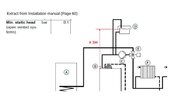But it's not a heat only is it? Vogues are either System or Combi and I've said I want a heat only. But see below for my acceptance of the second paragraph regarding pressurizing. .... I'm sure you're right in what you say there.
BUT, if I was to go pressurized you might well say "get a Vogue System boiler" and you'd be partly right except I prefer to have separate pump and expansion vessel (rightly or wrongly
It does seem a bit odd to me that Ideal don’t just do stainless hex across the board.
I wasn’t particularly recommending Ideal, only pointing they have the criteria you want in a system boiler
My main doubt concerns pressurizing the system and the possible leaks thereafter. He said it's very rare, and it may well be, but it still scares me.
It’s a valid concern, but I just replaced a 45 year old open vented heating system, I had to take up lots of floorboards to do radiator changes and some of the old central heating pipework wasn’t great, but I’ve the new system in place for a couple of weeks and it holds fine at 1.2 bar
If you have soldered copper pipework in conventional 22mm and 15mm, I would say go for a fully sealed pumped system.
Open vented is more likely to allow air into the system, which leads to corrosion and sludge, I think modern boilers are better on fully pumped.
If you are considering an unvented cylinder then the hot water side would be pressurised to over 2 bar, but heating is only pressurised to just over 1 bar.
But the debate regarding when to replace is acknowledged
I replaced a 45 year old Stelrad Ideal boiler, my old plumber who retired a few years ago used to say: its a very simple boiler with hardly any parts to go wrong and a cast iron hex, he was right but the cast iron hex eventually started leaking, hence our boiler breaking down in mid Jan when temps outside were -3c.
If you do replace, I recommend you make sure you go for a system setup that allows the boiler to run at low flow temperatures to make best use of efficiency. In that respect, Viesseman, Intergas, Vokera and Vaillant all have that designed into the boiler.
I used to have the heating set for shortish time morning and evening on a system with typical flow around 70
Now I have the new boiler setup timed from 5.30am to midday, then 4.00pm to 11.00pm and I’m finding the weather comp is setting the flow at around 44c return is around 38 - 40, but the house stays at an even temp, the rads are just slightly above warm and the house feels comfortably warm. Early indications show gas usage is around £2.80 per day (admittedly weather is hovering around 7-11 deg mostly).
If you are changing a working functional boiler albeit old, It’s worth getting the extra benefit of improved comfort levels from low flow temps as part of the upgrade. But you will probably need existing controls changed you probably have S or Y plan
The only thing I’m finding is the boiler can’t modulate down low enough, maybe because of the boiler, partly due to rads not being big enough to operate at really low flow temps.


